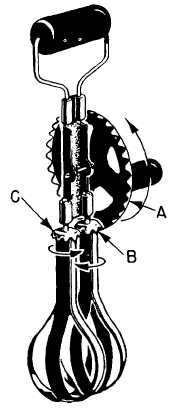CHAPTER 6
GEARS
CHAPTER LEARNING OBJECTIVES
Upon completion of this chapter, you should be able to do the following:
l Compare the types of gears and their advantages.
Did you ever take a clock apart to see what made it
tick? Of course you came out with some parts left over
when you got it back together again. And they probably
included a few gear wheels. We use gears in many
machines. Frequently the gears are hidden from view in
a protective case filled with grease or oil, and you may
not see them.
An eggbeater gives you a simple demonstration of
the three jobs that gears do. They can change the
direction of motion, increase or decrease the speed of
the applied motion, and magnify or reduce the force that
you apply. Gears also give you a positive drive. There
can be, and usually is, creep or slip in a belt drive.
However, gear teeth are always in mesh, so there can be
no creep and slip.
Follow the directional changes in figure 6-1. The
crank handle turns in the direction shown by the
arrow—clockwise—when viewed from the right. The
32 teeth on the large vertical wheel (A) mesh with the 8
teeth on the right-hand horizontal wheel (B), which
rotates as shown by the arrow. Notice that as B turns in
a clockwise direction, its teeth mesh with those of wheel
C and cause wheel C to revolve in the opposite direction.
The rotation of the crank handle has been transmitted by
gears to the beater blades, which also rotate.
Now figure out how the gears change the speed of
motion. There are 32 teeth on gear A and 8 teeth on gear
B. However, the gears mesh, so that one complete
revolution of A results in four complete revolutions of
gear B. And since gears B and C have the same number
of teeth, one revolution of B results in one revolution of
C. Thus, the blades revolve four times as fast as the crank
handle.
In chapter 1 you learned that third-class levers
increase speed at the expense of force. The same
happens with the eggbeater. The magnitude of force
changes. The force required to turn the handle is
greater than the force applied to the frosting by the
blades. This results in a mechanical advantage of less
than one.
TYPES OF GEARS
When two shafts are not lying in the same straight
line, but are parallel, you can transmit motion from
Figurc 6-1.—A simple gear arrangement.
6-1


